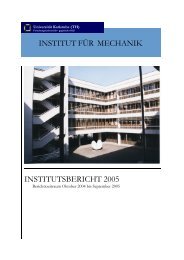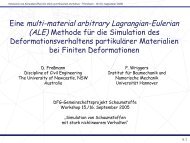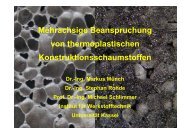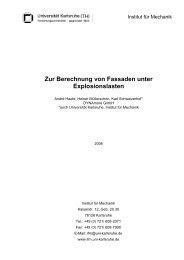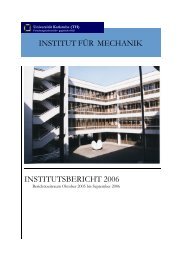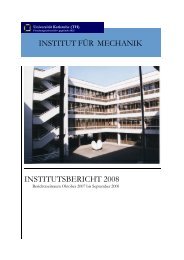Continuum mechanical modeling of processing induced initial ...
Continuum mechanical modeling of processing induced initial ...
Continuum mechanical modeling of processing induced initial ...
Create successful ePaper yourself
Turn your PDF publications into a flip-book with our unique Google optimized e-Paper software.
Institute <strong>of</strong> Mechanics<br />
<strong>Continuum</strong> <strong>mechanical</strong> <strong>modeling</strong><br />
<strong>of</strong> <strong>processing</strong> <strong>induced</strong> <strong>initial</strong> anisotropy<br />
in the finite strain deformation<br />
<strong>of</strong> amorphous thermoplastic polymers<br />
Philipp Hempel, Matthias Kotlik, Thomas Seelig<br />
15. International Conference on<br />
Deformation, Yield and Fracture <strong>of</strong> Polymers<br />
Kerkrade, April 2012<br />
Institute <strong>of</strong> Mechanics<br />
Kaiserstr. 12<br />
D-76131 Karlsruhe<br />
Tel.: +49 (0) 721/ 608-42071<br />
Fax: +49 (0) 721/608-47990<br />
E-Mail: info@ifm.kit.edu<br />
www.ifm.uni-karlsruhe.de
<strong>Continuum</strong> <strong>mechanical</strong> <strong>modeling</strong> <strong>of</strong> <strong>processing</strong> <strong>induced</strong> <strong>initial</strong><br />
anisotropy in the finite strain deformation <strong>of</strong> amorphous<br />
thermoplastic polymers<br />
P. Hempel, M. Kotlik, Th. Seelig<br />
Institute <strong>of</strong> Mechanics, Karlsruhe Institute <strong>of</strong> Technology (KIT), D-76131 Karlsruhe, Germany<br />
Summary: This work deals with <strong>modeling</strong> the <strong>mechanical</strong> behavior <strong>of</strong><br />
thermoplastic polymers in the finite strain regime over a wide range <strong>of</strong><br />
temperatures. Thereby, special emphasis is put on the incorporation <strong>of</strong><br />
an <strong>initial</strong> anisotropy in terms <strong>of</strong> ”frozen-in” molecular orientation which<br />
results from a preceding manufacturing process. A computational example<br />
is discussed which considers an injection molded plate undergoing<br />
inhomogeneous deformation (buckling) during re-heating.<br />
Introduction<br />
Manufacturing processes <strong>of</strong> amorphous thermoplastic polymers at elevated temperatures (e.g.<br />
injection molding) and subsequent rapid cooling result in an anisotropic microstructure due to<br />
”frozen-in” molecular orientation [5]. This state <strong>of</strong> pre-orientation in the solid material affects<br />
the subsequent finite strain deformation behavior in terms flow strength and hardening and may<br />
give rise to stress-free deformations <strong>of</strong> a component during re-heating.<br />
This ”memory-effect” can be observed at the injection molded plate in Fig. 1a. After uniformly<br />
heating the plate above the glass transition temperature it deforms and buckles due to the preoriented<br />
microstructure (Fig. 1c). To get some indication <strong>of</strong> the microstructure one can use polarized<br />
light to visualize (via birefringence) regions with high molecular orientation and residual<br />
stress (Fig. 1b).<br />
a) b) c)<br />
Figure 1: a) Injection molded plate, b) plate under polarized light, c) deformed plate after reheating<br />
above glass transition temperature<br />
The aim <strong>of</strong> this work is to model the <strong>mechanical</strong> behavior <strong>of</strong> thermoplastic polymers in the finite<br />
strain regime over a wide range <strong>of</strong> temperatures (above glass transition) with consideration <strong>of</strong> a<br />
<strong>processing</strong> <strong>induced</strong> <strong>initial</strong> anisotropy. Therefore, experimental test data at different temperatures<br />
and strain rates are necessary in order to describe the stress-strain response correctly. Uniaxial<br />
tension tests on PMMA at different strain rates and temperatures (below and above glass transition<br />
which for PMMA is T g ≈ 105 ◦ C) were performed. These tension tests were evaluated using<br />
digital image correlation [4] which allows to measure local strain fields needed to determine the
true stress-strain response <strong>of</strong> the material (Fig. 2). At moderate temperatures the material shows<br />
a glassy behavior with an elastic regime followed by inelastic deformation including progressive<br />
hardening. At higher temperatures, near to or above the glass transition, the material is in the<br />
rubbery state. Elastic strains then are much larger and the separation <strong>of</strong> elastic and inelastic<br />
deformation is less obvious. Furthermore, a rate dependency is observed which is more pronounced<br />
at high temperatures so that the glass transition is not a fixed temperature but is rate<br />
dependent as well.<br />
˙ε=10 −1 s −1<br />
a)<br />
˙ε=10 −3 s −1 b)<br />
Figure 2: Uniaxial tension tests at different temperatures and strain rates: a) ˙ε=10 −3 s −1 , b)<br />
˙ε=10 −1 s −1<br />
<strong>Continuum</strong> <strong>mechanical</strong> <strong>modeling</strong><br />
The material model presented here is based on that developed by Boyce and co-workers [1-3].<br />
Starting with the kinematics, the widely used multiplicative split <strong>of</strong> the deformation gradient into<br />
an elastic and plastic part is utilized<br />
F= F e F p (1)<br />
where F p defines the stress free configuration after elastic unloading (referred to as the intermediate<br />
configuration). Physically, F p describes permanent molecular orientation in the material.<br />
In order to include an <strong>initial</strong> anisotropy, the inelastic deformation gradient is complemented by<br />
an <strong>initial</strong> deformation gradient F i (= V i ) so that the network deformation tensor F n is defined as<br />
[2]<br />
F n = F p F i . (2)<br />
This network deformation tensor is used in the following to describe the entropic resistance <strong>of</strong><br />
the molecular network against plastic flow (see below).<br />
The split <strong>of</strong> the deformation gradient (1) leads to an additive decomposition <strong>of</strong> the velocity gradient<br />
tensor into an elastic and plastic part L= L e + L p with the inelastic velocity gradient in the<br />
current configuration L p = F e ˆL p F e−1 and in the intermediate configuration ˆL p = Ḟ p F p−1 . The<br />
latter can be decomposed as ˆL p = ˆD p + Ŵ p with the inelastic rate <strong>of</strong> deformation tensor ˆD p and<br />
the inelastic spin tensor Ŵ p , both in the intermediate configuration. While ˆD p is constitutively<br />
prescribed via a flow rule, the inelastic spin tensor can be computed as Ŵ p = W−W[D+ ˆD p ]<br />
with the forth order tensorW once the assumption <strong>of</strong> a symmetric elastic deformation gradient<br />
F eT = F e is made [3].<br />
The inelastic part <strong>of</strong> the rate <strong>of</strong> deformation tensor ˆD p in the intermediate configuration is determined<br />
by the deviatoric part <strong>of</strong> the driving stress tensor ˆΣ− ˆb and the plastic shear strain rate ˙γ p
according to<br />
ˆD p = ˙γ p ˆΣ ′ − ˆb ′<br />
| ˆΣ ′ − ˆb ′ |<br />
, ˙γ p = ˙γ p 0 exp ⎡⎢⎣ − As<br />
T<br />
⎛<br />
⎜⎝<br />
⎛⎜⎝ 1− | ˆΣ ′ − ˆb ′ ⎞ 5⎞⎤<br />
6<br />
|<br />
s<br />
⎟⎠ ⎟⎠⎥⎦<br />
(3)<br />
with material parameters A, s, ˙γ p 0<br />
and the temperature T.<br />
The driving stress ˆΣ− ˆb is the difference <strong>of</strong> the Mandel stress ˆΣ=det(F)F e σF e−1 (withσbeing<br />
the Cauchy stress tensor) and the backstress ˆb (Fig. 3a). The backstress tensor is determined<br />
from the Arruda-Boyce eight-chain-model [1]<br />
ˆb= CR√ ( )<br />
N<br />
L −1 λc<br />
√ ˆB n (4)<br />
3λ c N<br />
with the left Cauchy-Green tensor ˆB n = F n F nT , the inverse <strong>of</strong> the Langevin-functionL, the<br />
rubbery modulus C R , the average number N <strong>of</strong> rigid links between entanglements and the mean<br />
( ) 1<br />
1<br />
chain stretchλ c =<br />
3 tr ˆB n 2<br />
. In (4) use is made <strong>of</strong> the network deformation gradient tensor F<br />
n<br />
(2) so that an <strong>initial</strong> backstress can be prescribed. The Cauchy stressσdepends on the elastic<br />
left Cauchy-Green tensor B e = F e F eT and is determined from a hyperelastic Neo-Hooke model.<br />
In addition, the model is modified to capture a wide range <strong>of</strong> temperatures. Therefore, the shear<br />
modulus, the material parameter A in (3) and the molecular network parameter N are taken<br />
temperature dependent as suggested in [1]. In Fig. 3b the stress-strain response <strong>of</strong> the model is<br />
shown in comparison with experimental data.<br />
a) b)<br />
Figure 3: a) Rheological model, b) stress-strain response <strong>of</strong> the model (dashed lines) and experimental<br />
data (solid lines) for a strain rate <strong>of</strong> ˙ε=0.1s −1<br />
Computational example<br />
As a computational example the injection molded plate shown in Fig. 1a is investigated. An<br />
indication <strong>of</strong> the ”frozen-in” molecular orientation (and stretch) is provided by inspecting the<br />
plate under polarized light utilizing birefringence (Fig. 1b). This is used as a first guess for<br />
the distribution and magnitude <strong>of</strong> the <strong>initial</strong> molecular orientation where high or low values<br />
prevail in bright or dark regions, respectively. Mapping <strong>of</strong> this information to the FE model is<br />
accomplished by assuming a corresponding distribution <strong>of</strong> the maximum principal stretchλ i max<br />
(eigenvalue <strong>of</strong> V i , detV i = 1). For simplicity five sections with different constant values <strong>of</strong>λ i max<br />
are considered. The direction <strong>of</strong> the orientation is assumed to be radial from the injection point
(”gate”; see Fig. 1a). The plate is subjected to a temperature which is taken spatially uniform<br />
and increases with time. With increasing temperature the material flow resistance decreases and<br />
enables the ”frozen-in” molecular stretch (and backstress) to relax. This spatially non-uniform<br />
re-deformation causes buckling <strong>of</strong> the plate. The deformed FE model is depicted in Fig. 3b and<br />
shows a qualitatively good agreement with the real plate in Fig. 1c.<br />
a) b)<br />
Figure 4: FE analysis <strong>of</strong> injection molded plate: a) distribution <strong>of</strong> <strong>initial</strong> molecular stretch, b)<br />
deformation after heating to 120 ◦ C<br />
Conclusions<br />
In this work a constitutive model for amorphous thermoplastic polymers is set up which incorporates<br />
an <strong>initial</strong> anisotropy and is able to describe the stress-strain response even above the<br />
glass transition. The model is used successfully to simulate a re-heating process <strong>of</strong> an injection<br />
molded plate. The resulting deformation <strong>of</strong> the plate is in good agreement with that observed in<br />
the real experiment. The correlation between the deformation <strong>of</strong> the real plate and the deformation<br />
obtained in the simulation evidences that the assumed <strong>initial</strong> molecular orientation and its<br />
mapping to the computational model is reasonable. However, while the flow field in the present<br />
case is quite obvious, it is hardly conceivable that this heuristic method is applicable to more<br />
complicated geometries. In that case one could use, for example, form filling simulations to map<br />
the <strong>initial</strong> state <strong>of</strong> the material to the FE model. Another subject <strong>of</strong> future work is the modification<br />
<strong>of</strong> the material model to capture the effect <strong>of</strong> strain rate dependent hardening at elevated<br />
temperatures caused by reptation <strong>of</strong> molecules in the entanglement network.<br />
References<br />
[1] Arruda, E. M.; Boyce, M. C.; Jayachandran, R., Mechanics <strong>of</strong> Materials 1995, 19(2-3), 193-212<br />
[2] Boyce, M.C.; Parks, D.M.; Argon, A.S., International Journal <strong>of</strong> Plasticity 1989, 6, 593-615<br />
[3] Boyce, M.C.; Weber, G.G.; Parks, D.M., Journal <strong>of</strong> the Mechanics and Physics <strong>of</strong> Solids 1989,<br />
37(5),647-665<br />
[4] Limess, Digital Image Correlation. Q-400 Operation Manual, Krefeld 2009<br />
[5] Struik, L.C.E., Internal stresses, dimensional instabilities and molecular orientations in plastics, John<br />
Wiley & Sons Ltd, Chichester 1990



